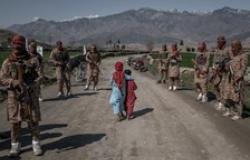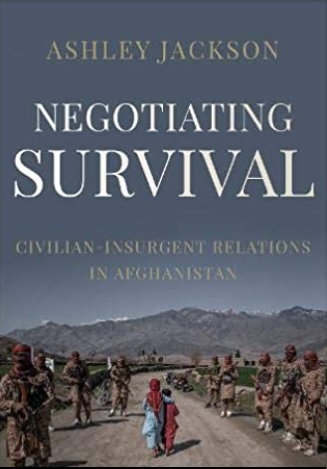Book Review - Negotiating Survival: Civilian–Insurgent Relations in Afghanistan by Ashley Jackson

Negotiating Survival: Civilian–Insurgent Relations in Afghanistan by Ashley Jackson. London: Hurst 2021. 328 pp., £30 hardcover 9781787384859
Ashley Jackson’s fascinating book, Negotiating Survival: Civilian-Insurgent Relations in Afghanistan, sheds light on the complex interactions between the insurgent groups and the civilians during the civil conflict. The book directs attention to the significance of subtle power dynamics between the rebels and civilians by asking questions like how do civilians and insurgents negotiate with each other? In answering this question, the book focuses particularly on the case of Afghanistan and the overtime variation in the bargaining dynamics of the Taliban and civilians across the areas of Taliban influence and control. The case study of Afghanistan is crucial; first, most studies have neglected the civilian perspective and behavior during the Afghan war. Second, the civil war dynamics in Afghanistan changed remarkably since 2001, resulting in the evolution of the role of the Taliban from governing an insurgency to governing the incumbent state. Such development not only has altered the Taliban’s strategies and tactics over time but has also put civilians in a challenging position to cope with the Taliban’s evolving nature. The approach and claim of the book are central to the burgeoning literature on rebel governance and the established field of counterinsurgency.
 The book argues that both insurgents and civilians are compelled to negotiate with each other in order to survive. They are locked in an interdependent relationship where ordinary people navigate and react to the violent political rule of insurgents, and the insurgents adapt to these civilian demands. The result is the formulation of a novel theory of insurgent-civilian bargaining that delves into these actors’ interests, leverage, and strategies. The Taliban strategy and tactics to bargain with civilians involve coercion, co-option, and cooperation. The Taliban used coercive measures to achieve minimal civilian compliance to eliminate any opposition or threat to the insurgency and send a message to dissuade others from opposing or obstructing them. Once the Taliban gained dominion over a specific area, they forced the people to accustom themselves to the change and abide by the new rules. In return for cooperation and cooptation, they provided protections, security, services, and economic opportunities to these people. Civilians had to navigate between the pro-government actors and insurgents and took sides as ‘neutrality is nigh on impossible’ (p.5). Picking sides of the conflict actors is an arduous task for civilians, especially in the context of the Afghan war since there has been a constant changing of territorial and governance control at the local and regional level between the pro-government forces and the Taliban. Also, taking one side invited retaliation from the other side. Hence civilians have to develop creative, calculated strategies to interact with the conflict parties. In retrospect, the commonly used terms in the literature of civil war such as ‘collaboration,’ ‘support,’ or ‘taking sides’ are superficial in understanding the fundamentals of the civilian-insurgent relationship.
The book argues that both insurgents and civilians are compelled to negotiate with each other in order to survive. They are locked in an interdependent relationship where ordinary people navigate and react to the violent political rule of insurgents, and the insurgents adapt to these civilian demands. The result is the formulation of a novel theory of insurgent-civilian bargaining that delves into these actors’ interests, leverage, and strategies. The Taliban strategy and tactics to bargain with civilians involve coercion, co-option, and cooperation. The Taliban used coercive measures to achieve minimal civilian compliance to eliminate any opposition or threat to the insurgency and send a message to dissuade others from opposing or obstructing them. Once the Taliban gained dominion over a specific area, they forced the people to accustom themselves to the change and abide by the new rules. In return for cooperation and cooptation, they provided protections, security, services, and economic opportunities to these people. Civilians had to navigate between the pro-government actors and insurgents and took sides as ‘neutrality is nigh on impossible’ (p.5). Picking sides of the conflict actors is an arduous task for civilians, especially in the context of the Afghan war since there has been a constant changing of territorial and governance control at the local and regional level between the pro-government forces and the Taliban. Also, taking one side invited retaliation from the other side. Hence civilians have to develop creative, calculated strategies to interact with the conflict parties. In retrospect, the commonly used terms in the literature of civil war such as ‘collaboration,’ ‘support,’ or ‘taking sides’ are superficial in understanding the fundamentals of the civilian-insurgent relationship.
The book’s major strength lies in its differentiation between three broad categories of civilians in its discussion of negotiations between civilians and the Taliban—customary authorities, private organizations, and individuals—each of which has distinct sources of leverage and types of interests. Customary authorities comprise leaders, religious officials, and elders of the village. In negotiations with the Taliban, customary authorities typically concentrate on collective issues or act as liaisons between the individual constituents and the governing bodies. Hence when insurgents seek to govern, such authorities become an invaluable link between civilians and the Taliban. The civilian organizations encompass a wide array of private organizations, including local and international NGOs, UN agencies, farming co-operatives, governmental entities, local businesses, and multinational corporations, among others operating in Afghanistan. They tend to negotiate in pursuit of their organizational interests and, in return, offer benefits in the form of financial payments, taxes, services, jobs, including others. Individuals or those negotiating with the Taliban on their behalf, usually in the pursuit of survival, have lesser influence and hold than the other two types of civilians. Consequently, they would not only secure little from the Taliban but would be able to return the favor in weak ways. Hence eventually, such individuals need to rely on other groups of civilians for better bargaining.
The book centers on extensive fieldwork in Afghanistan, drawing analysis from 418 interviews with members of the Taliban and civilians conducted in fifteen of Afghanistan’s thirty-four provinces, primarily between July 2017 and February 2019, resulting in a dense and rich qualitative picture of insurgent-civilian relations. Most of the interviewees included Taliban fighters, commanders, leaders, interlocutors, and ex-members; government officials, employees (including teachers and doctors) and aid workers; and civilians who have lived or are currently living under Taliban rule. The book is among very few studies that have chosen the fieldwork and direct interactions with insurgents in Afghanistan post-9/11. Hence, the effort and time invested in collecting manifold shreds of the micro-historical evidence to invigorate the argument and research design are commendable. Moreover, it provides rich, first-hand empirical data for the new researchers to conduct further studies on the topic.
Beyond the enthralling empirical contribution to our understanding of Afghanistan, the theoretical contribution of Negotiating Survival is ground-breaking. Jackson’s analysis advances our understanding of the civilians’ partiality and agency, allowing them to negotiate, resist, and sometimes even block insurgents’ actions. The argument resonates with the seminal work on rebel governance by scholars like Arjona (2015), Gowrinathan and Mampilly (2019), Masullo (2021), and Krause (2016). Furthermore, Jackson extends the understanding of civilian agency by stating that civilians do not have free choice when it comes to taking sides with armed actors. Such an extension insinuates the need to reevaluate and improve the counterinsurgency doctrine, which assumes civilians are malleable and easily capable of shifting sides.
There are two interlinked dimensions where the explanations of the book are limited. First, the book uses a broad definition of civilians “essentially anyone who is not bearing arms or actively fighting on one side or another” (p. 8). In a complex country like Afghanistan, defining civilians based on similarities and differences across time and space can be a strenuous yet rewarding task. The author’s extensive fieldwork could help to provide vital contributions in delineating how the term changes, generated, circulated, and understood among different constituencies, regions, and provinces of Afghanistan. Second, the book argues that there are blurry boundaries between the terms ‘civilians’ and ‘insurgents’ since they are part of the same cultural, social, and kinship fabric. However, it would be helpful to conceptualize the nuances of the two terms and try to position them and their in-betweens on the spectrum. Such an endeavor will help place the partners or children of insurgents, their friends, or relatives in the relevant categorization and categorize civilians who were previously insurgents and vice versa. These are some crucial aspects, and one hopes that the author will continue to explore them in her future works.
Negotiating Survival is thus essential reading for anyone studying Afghanistan or interested in the country’s political developments over the past few decades. The recent developments in Afghanistan, precisely the Taliban’s way of governing and their interactions with the civilians after the capture of Kabul in 2021, require meticulous analysis of the Taliban’s engagement with segments of the civilian population over the past decades. Moreover, the book’s emphasis on variation in civil-insurgent relationships over time and space, along with the categorization of civilians, provides an interesting lens to observe the recent tactics of the Taliban and their dealing with civilians. Hence, the book aids in exploring the Taliban-civilian interactions from a new perspective, combined with other thought-provoking dimensions for future research.
Maria Amjad is a doctoral candidate in Security and Strategic Studies at the University of Genoa. Email: Mariaamjad309@gmail.com
References
Arjona, A. (2015). Civilian Resistance to Rebel Governance (pp. 180–202). In Rebel Governance in Civil War by Arjona, A., Kasfir, N., & Mampilly, Z. (2015). Cambridge University Press.
Gowrinathan, N., & Mampilly, Z. (2019). Resistance and Repression under the Rule of Rebels: Women, Clergy, and Civilian Agency in LTTE Governed Sri Lanka. Comparative Politics, 52(1), 1–20. https://doi.org/10.5129/001041519x15698352040097
Masullo, J. (2021). Refusing to Cooperate with Armed Groups Civilian Agency and Civilian Noncooperation in Armed Conflicts. International Studies Review, 23(3), 887–913. https://doi.org/10.1093/isr/viaa090
Krause, J. Non-violence and civilian agency in communal war: Evidence from Jos, Nigeria, African Affairs, Volume 116, Issue 463, April 2017, Pages 261–283, https://doi.org/10.1093/afraf/adw068


